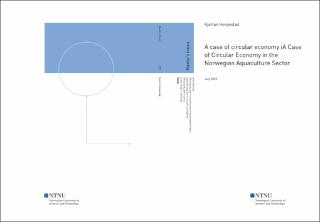| dc.contributor.advisor | Deshpande, Paritosh | |
| dc.contributor.advisor | Hepsø. Marion Olsen | |
| dc.contributor.author | Horpestad, Kjartan | |
| dc.date.accessioned | 2024-01-16T18:20:05Z | |
| dc.date.available | 2024-01-16T18:20:05Z | |
| dc.date.issued | 2023 | |
| dc.identifier | no.ntnu:inspera:147161422:152970600 | |
| dc.identifier.uri | https://hdl.handle.net/11250/3112009 | |
| dc.description.abstract | Oppdrettsnæringen har blitt en betydelig faktor i å møte verdens protein- etterspørsel, og dermed vokst til å bli en av Norges største næringer. Klimakrisen, sammen mutviklingshastigheten i Norsk oppdrettsnæring fører til både behov- og potensiale for en bærekraftig utvikling i sektoren.
Denne oppgaven tar for seg den nåværende tilstanden for sirkularitet i den norske akvakultursektoren, og ved hjelp av bedriftsbesøk og materiellvitenskap identifiseres kunnskapshull og utfordringer som må løses. Pyrolyse-gasskromatografi/massespektrometri (Py-GC/MS) ble brukt til å analysere polymerene og lete etter kjemiske endringer under resirkuleringsprosessen.
I tillegg til tetthetsendringer og redusert 'melt flow rate' (MFR), ble det observert tap av tilsetningsstoffer under resirkuleringen. Kunnskapshull gjør det nødvendig med ytterligere arbeid for å fastslå effektene og hvordan man eventuelt kan reversere dem. Generelt sett vil integrering av tverrfaglig materiellvitenskap bidra til fylle disse hullene og øke sirkulariteten, ettersom nåværende praksis hovedsakelig fokuserer på fysiske egenskaper. | |
| dc.description.abstract | As the global demand for protein is increasing, the aquaculture industry have become significant factor in meeting this demand and is in turn growing to be one of Norway’s biggest industries. The speed of development, along with the growing environmental challenges, gives both potential and need for a sustainable development within the sector.
This thesis takes a look at the current status of circularity in the Norwegian aquaculture sector, and along with company visits and material science identify knowledge gaps and challenges moving forward. Pyrolysis-Gas Chromatography/Mass Spectrometry (Py-GC/MS) was used to analyse the polymers and look for chemical changes during the recycling process.
In addition to the observed density changes and reduces Material Flow Rate (MFR), a loss of additives during recycling was observed. Knowledge gaps make further work necessary to determine the effects and how to reverse them. Overall, a higher integration of interdisciplinary material sciences could help close gaps and increase circularity, as current practices focus mainly on physical properties. | |
| dc.language | eng | |
| dc.publisher | NTNU | |
| dc.title | A case of circular economy in the Norwegian aquaculture sector | |
| dc.type | Master thesis | |
